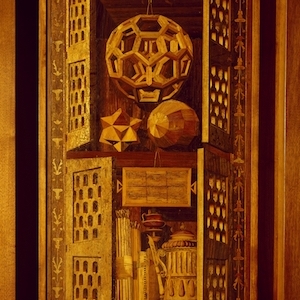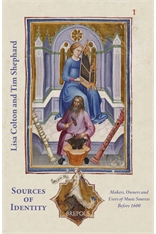I’m pleased to announce the publication of a new chapter on music iconography. The chapter, entitled “The Harmonious Blacksmith, Lady Music and Minerva: The Iconography of Secular Song in the Late Middle Ages”, has appeared in print in a collection of essays Music, Myth and Story in Medieval and Early Modern Culture, edited by Katherine Butler and Samantha Bassler. Published by Boydell & Brewer, the production quality is tremendous and the editors have done a marvellous job of assembling fifteen chapters that explore the myriad mythologies (beyond the well-known Orpheus story) that shaped not only musical thought, but also its styles, techniques, and practices from the ninth to seventeenth centuries in Europe. Five colour plates (of a total of ten) accompany my essay and further increase its impact.

The following is an abstract of my chapter:
A number of fifteenth-century Italian collections of polyphonic song feature at or near their beginning historiated initials showing a bearded figure beating an anvil with two hammers. In his early seminal article, Paul Beichner argues that late medieval literary and artistic sources often confuse the iconography of Jubal, the biblical inventor of music, and his brother Tubalcain, the inventor of smithing and warfare. Part of the fault seems to lie centuries earlier with Peter Comestor who conflated the biblical tradition with the Hellenistic story of Pythagoras’ discovery of music’s proportions. No matter who the blacksmith was for different medieval authors or artists, the underlying iconography is pervasive, symbolizing the musical arts in the vernacular vein. Authors have been quick to accept that the association of this harmonious blacksmith with Lady Music by fourteenth- and fifteenth-century illuminators and painters requires no further explanation. This chapter proposes that the association of Lady Music and the musical blacksmith draws upon the iconography of Minerva, especially in the manuscript tradition of Giovanni Boccaccio’s De mulieribus claris. Two conclusions are reached. First, a fresh understanding of the place of notated songbooks in late medieval musical culture emerges which situates them as objects of musical skill, artistic commerce and learning. Second, recognition of the pervasiveness of the iconography of Minerva provides the basis of a new reading of Dosso Dossi’s Allegory of Music (c.1522), which features two canons, one by Josquin and another possibly by Willaert.
Abstract by the author.
Unfortunately it is not possible to provide an open-access PDF of the chapter on this blog. For a limited time, however, Boydell & Brewer are offering customers a 25% discount on the usual price of the book (GBP £60/USD $99).
Order online at www.boydellandbrewer.com. Please be sure to quote reference BB125 when prompted (online this will be at the checkout). This offer ends 10 June 2019.



![Saint Anthony of Padua Reading by Cosimo Tura [Public domain], via Wikimedia Commons](https://jjstoessel.files.wordpress.com/2014/02/cosmc3a8_tura_-_st_anthony_of_padua_reading_-_wga23151.jpg)
You must be logged in to post a comment.